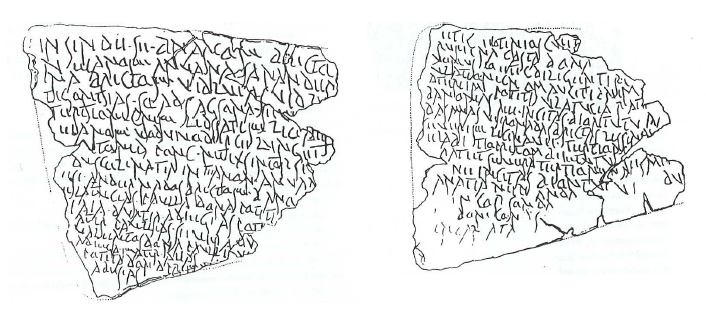A) Matir and materem (‘mother’): Plomb du Larzac
The Celtic word for ‘mother’ is attested in the nominative singular form mātīr in a Gallo-Latin inscription from Larzac, engraved on a lead plaque, composed of two fragments, inscribed on each side.105 The ‘Plomb du Larzac’ was found in 1983 on the opening of a funerary urn, on the Gallo-Roman necropolis of Hospitalet-du-Larzac, known as La Vayssière (Aveyron). This text, dating from the end of the 1st c. AD, is the longest text in the Gaulish language which has been discovered so far – about sixty lines and one hundred and seventy words or fragments of words. In La langue gauloise, Lambert offers a translation of some parts of the text, which contains various magical formulas and a list of names of women, one of whom, Severa Tertionicna, may be a sorceress. The text also gives the lineage between mothers and daughters, which is quite unusual, for it is generally the name of the father which is specified. The word mātīr thus appears on face 1a, lines 11-12 and 14: poti[ta m]atir paullias, ‘Potita mother of Paullias’, adiega matir aiias, ‘Adiega mother of Aiias’, and on face 1b, lines 5-6: ulatucia mat[ir] banonias, ‘Vlatucia mother of Banona’ (fig. 2).

The word ‘mother’ may also appear in the accusative singular form materem, with a possible Latinized inflexion –em (cf. the Latin inflexion of mātrem), on face 1b, lines 4-5 of the Plomb du Larzac: auciticni(m) materem potiti, which Lambert translates as ‘Aucitiona, mother of Potitos’.106 Here the filiation would be between a mother and her son, for Potitos is a masculine proper name.107 Despite its possible evolution from Latin mātrem, Delamarre asserts that the form materem is in accordance with the archaic Indo-European type, cf. Sanskrit mātáram, Greek mētéra, and Lithuanian móterį (*mātérm)108